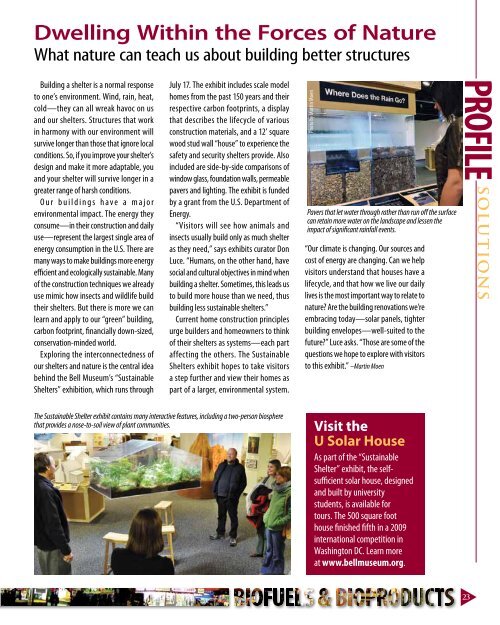PDF Version - College of Food, Agricultural and Natural Resource ...
PDF Version - College of Food, Agricultural and Natural Resource ...
PDF Version - College of Food, Agricultural and Natural Resource ...
Create successful ePaper yourself
Turn your PDF publications into a flip-book with our unique Google optimized e-Paper software.
Dwelling Within the Forces <strong>of</strong> Nature<br />
What nature can teach us about building better structures<br />
Building a shelter is a normal response<br />
to one’s environment. Wind, rain, heat,<br />
cold—they can all wreak havoc on us<br />
<strong>and</strong> our shelters. Structures that work<br />
in harmony with our environment will<br />
survive longer than those that ignore local<br />
conditions. So, if you improve your shelter’s<br />
design <strong>and</strong> make it more adaptable, you<br />
<strong>and</strong> your shelter will survive longer in a<br />
greater range <strong>of</strong> harsh conditions.<br />
Our buildings have a major<br />
environmental impact. The energy they<br />
consume—in their construction <strong>and</strong> daily<br />
use—represent the largest single area <strong>of</strong><br />
energy consumption in the U.S. There are<br />
many ways to make buildings more energy<br />
efficient <strong>and</strong> ecologically sustainable. Many<br />
<strong>of</strong> the construction techniques we already<br />
use mimic how insects <strong>and</strong> wildlife build<br />
their shelters. But there is more we can<br />
learn <strong>and</strong> apply to our “green” building,<br />
carbon footprint, financially down-sized,<br />
conservation-minded world.<br />
Exploring the interconnectedness <strong>of</strong><br />
our shelters <strong>and</strong> nature is the central idea<br />
behind the Bell Museum’s “Sustainable<br />
Shelters” exhibition, which runs through<br />
July 17. The exhibit includes scale model<br />
homes from the past 150 years <strong>and</strong> their<br />
respective carbon footprints, a display<br />
that describes the lifecycle <strong>of</strong> various<br />
construction materials, <strong>and</strong> a 12’ square<br />
wood stud wall “house” to experience the<br />
safety <strong>and</strong> security shelters provide. Also<br />
included are side-by-side comparisons <strong>of</strong><br />
window glass, foundation walls, permeable<br />
pavers <strong>and</strong> lighting. The exhibit is funded<br />
by a grant from the U.S. Department <strong>of</strong><br />
Energy.<br />
“Visitors will see how animals <strong>and</strong><br />
insects usually build only as much shelter<br />
as they need,” says exhibits curator Don<br />
Luce. “Humans, on the other h<strong>and</strong>, have<br />
social <strong>and</strong> cultural objectives in mind when<br />
building a shelter. Sometimes, this leads us<br />
to build more house than we need, thus<br />
building less sustainable shelters.”<br />
Current home construction principles<br />
urge builders <strong>and</strong> homeowners to think<br />
<strong>of</strong> their shelters as systems—each part<br />
affecting the others. The Sustainable<br />
Shelters exhibit hopes to take visitors<br />
a step further <strong>and</strong> view their homes as<br />
part <strong>of</strong> a larger, environmental system.<br />
The Sustainable Shelter exhibit contains many interactive features, including a two-person biosphere<br />
that provides a nose-to-soil view <strong>of</strong> plant communities.<br />
Photo by David Hansen<br />
Photo by Martin Moen<br />
Pavers that let water through rather than run <strong>of</strong>f the surface<br />
can retain more water on the l<strong>and</strong>scape <strong>and</strong> lessen the<br />
impact <strong>of</strong> significant rainfall events.<br />
“Our climate is changing. Our sources <strong>and</strong><br />
cost <strong>of</strong> energy are changing. Can we help<br />
visitors underst<strong>and</strong> that houses have a<br />
lifecycle, <strong>and</strong> that how we live our daily<br />
lives is the most important way to relate to<br />
nature? Are the building renovations we’re<br />
embracing today—solar panels, tighter<br />
building envelopes—well-suited to the<br />
future?” Luce asks. “Those are some <strong>of</strong> the<br />
questions we hope to explore with visitors<br />
to this exhibit.” –Martin Moen<br />
Visit the<br />
U Solar House<br />
As part <strong>of</strong> the “Sustainable<br />
Shelter” exhibit, the selfsufficient<br />
solar house, designed<br />
<strong>and</strong> built by university<br />
students, is available for<br />
tours. The 500 square foot<br />
house finished fifth in a 2009<br />
international competition in<br />
Washington DC. Learn more<br />
at www.bellmuseum.org.<br />
PrOFilE solutions<br />
23

















